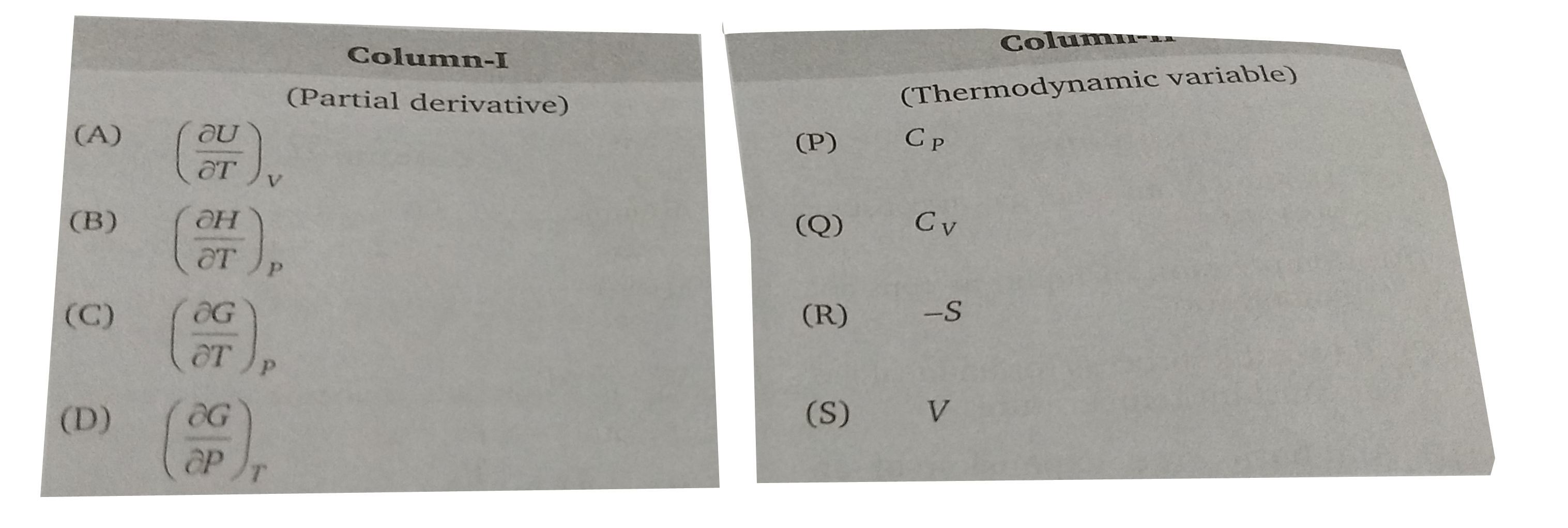Using the listed [ΔG∘f values] calculate ΔG∘ for the reaction :
3H2S(g)[−33.6]+2HNO3(l)[−80.6]→2NO(g)[+86.6]+4H2O(l)[−237.1]+3S(s)[0.0]Solution in Punjabi
−513.2
−1037.0
+433.4
+225.0
The correct Answer is:A
ΔG∘=2×86.6+4×(−237.1)
+3×0−3(−33.6)
−2(−80.6)=−513.2
Topper's Solved these Questions
- BOOK - NARENDRA AWASTHICHAPTER - THERMODYNAMICSEXERCISE - Level 3 - One Or More Answers Are Correct1videos
THERMODYNAMICS
- BOOK - NARENDRA AWASTHICHAPTER - THERMODYNAMICSEXERCISE - Level 3 - Match The Column2videos
THERMODYNAMICS
- BOOK - NARENDRA AWASTHICHAPTER - THERMODYNAMICSEXERCISE - Level 2 (Q.1 To Q.30)1videos
THERMODYNAMICS
- BOOK - NARENDRA AWASTHICHAPTER - STOICHIOMETRYEXERCISE - Level 3 - Subjective Problems20videos
STOICHIOMETRY
Similar Questions
Assume ideal gas behaviour for all the gases considered and neglect vibrational degrees of freedom. Separate equimolar sample. Separate equimolar samples of Ne, O2 , CO2 and SO2 were subjected to a two process as mentioned. Initially all are at same state of temperature and pressue.
Step I → All undergo reversible adiabatic expansion to attain same final volume, which is double the original volume thereby causing the decreases in their temperature.
Step → After step I all are given appropriate amount of heat isochorically to restore the original temperature.
Mark the correct option(s) :03:26View SolutionMatch the following columns
 07:26View Solution
07:26View SolutionWrite structure of 2,2-dimethylheptane.
01:46View SolutionWhat volume of a liquid (in L) will contain 10 mole ? If molar mass of liquid is 280 and its density is 1.4 g/mL.
03:08View SolutionIdentify the oxidant and reductant in the following reactions:
a. 10⊕(aq)+4Zn(s)+NOө3(aq)→4Zn2+(aq)+NH⊕4(aq)+3H2O(l)
b. I2(g)+H2S(g)→2Hl(g)+S(s)02:37View SolutionCalculate Delta_(r)G^(Theta) for the following reactions using Delta_(f)G^(Theta) values and and predict which reactions are spontaneous. a. Ca(s) +CI_(2)(g) rarr CaCI_(2)(s) b. H_(2)O(s) rarr Hg(l) +(1)/(2)O_(2)(g) c. NH_(3)(g) +2O_(2)(g) rarr HNO_(3)(l) +H_(2)O(l) Delta_(f)G^(Theta) value (kJ mol^(-1)) are: CaCI_(2)(s) =- 748.1, HgO(s) =- 58.84 NH_(3)(g) =- 16.45, HNO_(3)(l) = - 80.71 , H_(2)O(l) =- 237.13
03:52View SolutionIn the following reaction, 2H_(2)S(g)+SO_(2)(g) rarr 3S(s)+2H_(2)O(l) One equivalent of H_(2)S(g) will reduce
02:37View SolutionUse the information in the table to calculate the enthalpy of this reaction . C_(2)H_(6)(g)+(7)/(2)O_(2)(g)to2CO_(2)(g)+3H_(2)O(l) {:(Reaction ,DeltaH_(f)^(@)KJ.mol^(-1)),(2C(s)+3H_(2)(g)toC_(2)H_(6)(g),-84.7),(2C(s)+O_(2)(g)toCO_(2)(g),-393.5),(H_(2)(g)+(1)/(2)O_(2)(g)toH_(2)O(l),-285.8):}
01:45View SolutionThe E^(@) at 25^(@) C for the following reaction is 0.55 V. Calculate the DeltaG^(@) in kJ // mol : 4BiO^(+)(aq)+3N_(2)H_(5)^(+)to4Bi(s)+3N_(2)(g)+4H_(2)O(l)+7H^(+)
02:21View SolutionUsing the listed [ΔG∘f values] calculate ΔG∘ for the reaction :
3H2S(g)[−33.6]+2HNO3(l)[−80.6]→2NO(g)[+86.6]+4H2O(l)[−237.1]+3S(s)[0.0]01:57View SolutionDiborane is formed the element as shown in equation (1) 2B(s) + 3H_(2)(g) rarr 3B_(2)H_(6)(g)"…….."(1) Given that {:(H_(2)O(l)rarrH_(2)O(g),DeltaH_(1^(@))=44kJ),(2B(s)+3//2O_(2)(s)rarrB_(2)O_(3)(s),DeltaH_(2^(@))=-1273kJ),(B_(2)H_(6)(g)+3O_(2)(g)rarrB_(2)O_(3)(s)+3H_(2)O(g),DeltaH_(3^(@))=-2035 kJ),(H_(2)(g)+1//2O_(2)(g)rarrH_(2)O(l),DeltaH_(4^(@))=-286kJ):} the DeltaH^(@) for the reaction (1) is -
03:07View SolutionCalculate the standard free energy change for the reaction : Fe_(2)O_(3)(s) + 4H_(2)(g) rarr2Fe(s) + 3H_(2)O(l) Given that the standard free energies of formation of Fe_(2)O_(3) and H_(2)O are - 741.0 and -237.2kJ mol^(-1) respectively.
02:23View SolutionK_(rho) for the following reaction will be equal to 3Fe(s)+4H_(2)O(g)hArrFe_(3)O_(4)(s)+4H_(2)(g)
04:57View SolutionCalculate H∘ for the reaction ,
Na2O(s)+SO3(g)→Na(2)SO4(g)
(A)Na(s)+H2O(l)→NaOh(s)+12H2(g)
ΔH∘)=−146kJ
(B) Na2SO4(s)+(H)2O(l)→2Na(s)+SO3(g)
ΔH∘=+418kJ
(C) 2Na2O(s)+2H2(g))→4Na(s)+2H2O(l)
ΔH∘=+259kJ01:50View SolutionThe factor of DeltaG values is important in metallurgy. The DeltaG values for the following reactions at 800°C are given as : S_(2)(s) + 2O_(2)(g) to 2SO_(2)(g), DeltaG =-544 kJ 2Zn(s) + S_(2)(s) to 2ZnS(s), DeltaG=-293 kJ 2Zn(s) + O_(2)(g) to 2ZnO(s), DeltaG = -480 kJ Calculate the DeltaG for the reaction: 2ZnS(s) + 3O_(2)(g) to 2ZnO(s) + 2SO_(2)(g)
04:05View SolutionWhich of the following statements about the given reaction are correct ?
3Fe(s)+4H2O(l)→Fe3O4(s)+4H2(g)07:11View Solution

